Friday night’s flammulated owl (“flam”) seminar, taught by Colorado College biology professor Brian D. Linkhart, was a success. Unlike last year, this year’s weather was good for insects, and most of the flam nests at the Manitou Experimental Forest, where Linkhart has worked since 1981, are doing fine. Click on the thumbnails below to see larger photos
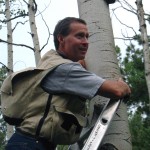 We began the evening by heading out to an easily accessible nest. Flams nest in abandoned flicker cavities, which can be as high as 70 feet off the ground, but this nest is only about eight feet off the ground and can be accessed with a ladder. Reaching the higher nests requires climbing spikes. For those nests, Linkhart has to climb the tree and lower the owlets down to his students so they can weigh and measure the owlets.
We began the evening by heading out to an easily accessible nest. Flams nest in abandoned flicker cavities, which can be as high as 70 feet off the ground, but this nest is only about eight feet off the ground and can be accessed with a ladder. Reaching the higher nests requires climbing spikes. For those nests, Linkhart has to climb the tree and lower the owlets down to his students so they can weigh and measure the owlets.
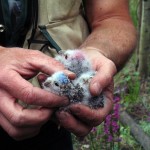 Flams typically lay two or three eggs in a nesting season. This nest has three owlets, all about 11 days old; each owlet weighs about 30-40 grams, approximately half of their adult weight. The flammulated owl (Otus flammeolus) is the second smallest North American owl. These owlets still have much of the white down they developed after hatching, as well as the beginnings of gray juvenile plumage. Since they’re not yet old enough to band, Linkhart uses markers to color their head feathers to tell them apart. This does not harm the owlets.
Flams typically lay two or three eggs in a nesting season. This nest has three owlets, all about 11 days old; each owlet weighs about 30-40 grams, approximately half of their adult weight. The flammulated owl (Otus flammeolus) is the second smallest North American owl. These owlets still have much of the white down they developed after hatching, as well as the beginnings of gray juvenile plumage. Since they’re not yet old enough to band, Linkhart uses markers to color their head feathers to tell them apart. This does not harm the owlets.
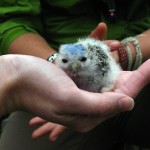 Blue is the runt of the nest, almost 10 grams lighter than its siblings. Flam nests always have a runt, which almost always survives to fledging and catches up in size to its nestmates. In fact, flam owlets have a very high survival rate until fledging–their main predator is the red squirrel. After fledging the owlets are much more vulnerable to a variety of predators, including mountain lions, coyotes, great horned owls, and particularly sharp-shinned hawks.
Blue is the runt of the nest, almost 10 grams lighter than its siblings. Flam nests always have a runt, which almost always survives to fledging and catches up in size to its nestmates. In fact, flam owlets have a very high survival rate until fledging–their main predator is the red squirrel. After fledging the owlets are much more vulnerable to a variety of predators, including mountain lions, coyotes, great horned owls, and particularly sharp-shinned hawks.
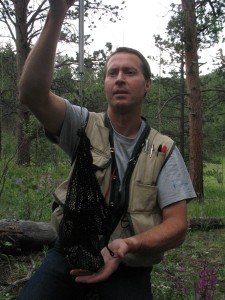 After hatching, the owlets are weighed every day. “You have to learn to be very mindful of your impact on the animals you’re studying,” Linkhart said. “In this case it means timing your work just right.” During the first week, when the owlets cannot regulate their own body temperature, the owlets can only be handled during the brief period at dusk when the female leaves the nest. By 11 days, these owlets can easily spend 20 minutes out of the nest, but Linkhart and his crew handle them during the evening, while the female is still inactive. Right now, these owlets are gaining about 4 grams a day from the diet of moths the male brings back to the nest.
After hatching, the owlets are weighed every day. “You have to learn to be very mindful of your impact on the animals you’re studying,” Linkhart said. “In this case it means timing your work just right.” During the first week, when the owlets cannot regulate their own body temperature, the owlets can only be handled during the brief period at dusk when the female leaves the nest. By 11 days, these owlets can easily spend 20 minutes out of the nest, but Linkhart and his crew handle them during the evening, while the female is still inactive. Right now, these owlets are gaining about 4 grams a day from the diet of moths the male brings back to the nest.
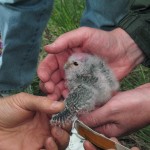 It’s also important to measure the growth of the flight feathers. Because of their nesting habits, baby flams don’t get to practice before fledging. Their first flight is normally straight down. They then climb back up the tree, flapping their wings for assistance, and repeat the process until they achieve flight. This is one of the times flams are most vulnerable to predators. The tiny adults can do little to defend their young, although they supervise the initial flights, each parent watching out for one or two fledglings.
It’s also important to measure the growth of the flight feathers. Because of their nesting habits, baby flams don’t get to practice before fledging. Their first flight is normally straight down. They then climb back up the tree, flapping their wings for assistance, and repeat the process until they achieve flight. This is one of the times flams are most vulnerable to predators. The tiny adults can do little to defend their young, although they supervise the initial flights, each parent watching out for one or two fledglings.
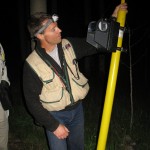 After dark we headed out to a nest Linkhart and his student crew had discovered a few days before. This nest had not yet been monitored, and we took an infrared “cavity peeper” to look into it. Unfortunately, the nest had been attacked by squirrels, which eat flam eggs. We moved to a different nest and attempted to capture an adult. Unfortunately, although we saw the adults hunting and bringing moths to the nest, we were unable to capture one.
After dark we headed out to a nest Linkhart and his student crew had discovered a few days before. This nest had not yet been monitored, and we took an infrared “cavity peeper” to look into it. Unfortunately, the nest had been attacked by squirrels, which eat flam eggs. We moved to a different nest and attempted to capture an adult. Unfortunately, although we saw the adults hunting and bringing moths to the nest, we were unable to capture one.
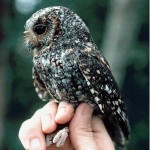 The adult flam stands only about six inches tall, with a 14-inch wingspan. It is the only North American owl its size with dark eyes. Flams nest almost exclusively in mature ponderosa pine forests. When Linkhart began studying flams in 1981, they were almost unknown. “I was working with accipiter hawks–forest hawks that are pretty sensitive. Richard Reynolds alerted me to the fact that flams were poorly known,” said Linkhart. “So one night he suggested we go out and look for some–moonlighting, so to speak. We found some, and that was really exciting. This was a niche that hadn’t been filled.”
The adult flam stands only about six inches tall, with a 14-inch wingspan. It is the only North American owl its size with dark eyes. Flams nest almost exclusively in mature ponderosa pine forests. When Linkhart began studying flams in 1981, they were almost unknown. “I was working with accipiter hawks–forest hawks that are pretty sensitive. Richard Reynolds alerted me to the fact that flams were poorly known,” said Linkhart. “So one night he suggested we go out and look for some–moonlighting, so to speak. We found some, and that was really exciting. This was a niche that hadn’t been filled.”
Over the past 26 years, Linkhart and his colleagues have dramatically expanded our knowledge of flams, but many questions remain. Some of the questions about population, reproduction, and demography can only be asked because Linkhart’s study has been so long-term, a rareity in the field of ecology. “It’s probably fair to say in any part of science that it’s difficult to carry out any study for more than five years. Funding is definitely a factor,” he said. “I’ve been fortunate to be carrying out this study for so long.”
Linkhart has several projects in progress regarding the flams, in addition to the reproduction data he’s been collecting for years. He is currently seeking funding to analyze blood samples from chicks collected over the course of the study in order to assess sex ratios.
Enough questions about this elusive species remain for another 26 years of research. This seminar provided an unusual opportunity for the participants to see active and unusually in-depth scientific research, as well as the chance to see a shy and unusual species up close.
-Melissa Barton
Photo Credits: Melissa Barton, except for adult flam (USGS/Greg Lasley)
This post featured in I and the Bird #58.
